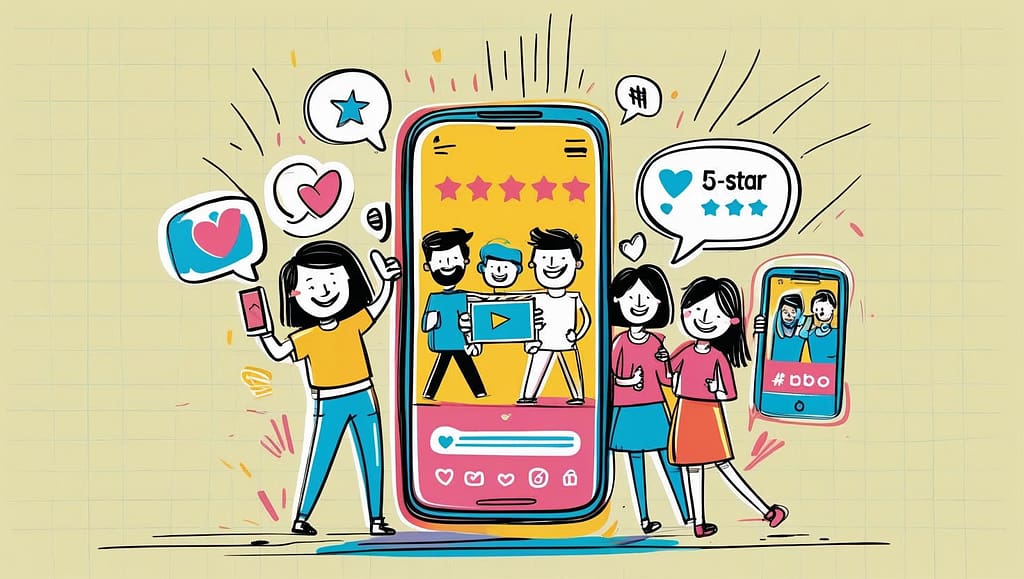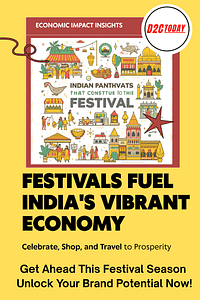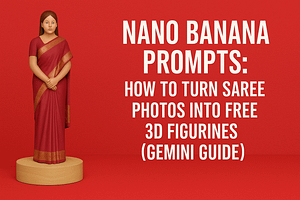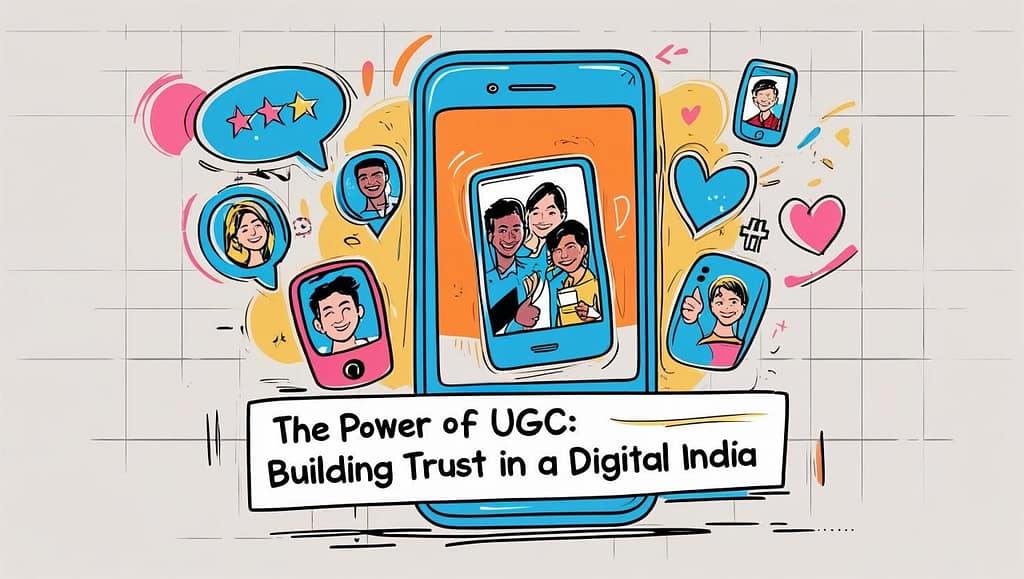User Generated Content (UGC) isn’t just a marketing tactic. For digital-first brands, it’s your MOST powerful asset to build trust at scale.
In my journey of Managing consumer brand and Observing Hours on various Social Media Platform ecommerce Platforms, I Observed that Branded content shouts, but UGC whispers in a friend’s voice. And in a trust-deficit digital world, that whisper wins.
Why UGC trumps polished branded content for authority & authenticity
✅ Social Proof, Not Sales Talk: A review from a real customer in Pune holds more weight than my perfectly scripted ad. It’s unbiased validation.
✅ Relatability Over Production: Glossy content can feel distant. UGC is raw, real, and relatable—exactly what the Indian consumer connects with.
✅ The Authenticity Engine: It builds a community, not just an audience. When users create for you, they become your biggest brand advocates.
For digital-first brands, your audience is your media channel. Your goal isn’t to just create a brand, but to cultivate a movement where your users create for you.
That’s how you build unshakeable authority.
UGC: The Authenticity Engine Powering India’s Top Consumer Brands
In the bustling, vibrant, and incredibly competitive Indian consumer market, building a brand isn’t just about having a great product. It’s about building trust. For years, brands relied on polished, high-budget advertisements to shout their message from the rooftops.
But the digital Indian consumer, savvy and skeptical of traditional advertising, is no longer listening to the shout. They’re leaning in to hear the whisper of a friend’s recommendation.
This is where User-Generated Content (UGC) isn’t just a marketing tactic; it’s the most powerful authenticity engine a modern brand can possess.
What exactly is User Generated Content (UGC)?
In its simplest form, UGC is any form of content including photos, videos, reviews, testimonials, or stories created by unpaid individuals (your customers and fans) rather than by the brand itself. It’s the digital equivalent of word-of-mouth, scaled to millions.

Think of it this way:
Branded Content: A stunning, professionally shot ad for a new smartphone.
UGC: A video from a recent college-goer in Delhi showing how that same smartphone’s battery easily lasts through a day of lectures, commute, and late-night scrolling.
The latter isn’t just an ad; it’s a real, relatable, and trusted experience.
Why UGC is Non-Negotiable for Indian Brands Today
Having been involved in building brands from scratch in this dynamic landscape, I’ve seen the shift firsthand. The Indian consumer, especially the digitally-native Gen Z and millennials, craves authenticity. They seek social proof before making a purchase decision. UGC delivers this in spades:
Builds Unshakeable Trust: A review from a real person in Pune or a style photo from a customer in Kolkata is unbiased validation. It’s proof that your product delivers on its promise in the messy, real world, not just in a sterile studio.
Drives Relatability: India is diverse. A “one-size-fits-all” ad campaign often fails to resonate across cultures. UGC automatically reflects this diversity, showing your product through the lens of countless different lives, making your brand infinitely more relatable.
Fuels Community, Not Just Audience: When you encourage and share UGC, you’re not just building an audience; you’re cultivating a community of passionate advocates. These users feel seen, heard, and valued, transforming them from one-time buyers into lifelong brand loyalists.
Cost-Effective & Scalable: While not free (it requires curation and strategy), UGC is a highly efficient way to generate a massive volume of authentic marketing material. Your customers become your creative team.
Learning from the Best: Impactful UGC Campaigns in India
The theory is solid, but the proof is in the campaigns. Here are some of India’s most impactful UGC campaigns that masterfully built authority and authenticity:
Myntra’s Fashion Haul Campaigns
Objective: Boost engagement and showcase real customer styling.
Execution: Myntra encouraged users to share photos of their fashion hauls using hashtags like #MyntraHaul. They featured the best UGC on their website and social media, creating a community-driven style guide.
Impact: Increased trust and conversion rates, as shoppers relied on peer reviews and real-life visuals .
In the world of fashion, seeing is believing. Myntra brilliantly leveraged its massive user base by encouraging them to share photos and videos of their purchased outfits. This created a vast, ever-growing library of real people showcasing real styles, drastically reducing purchase hesitation and building immense trust for online fashion shopping.
Apple’s “Shot on iPhone” Campaign
Objective: Highlight the camera quality of iPhones through user creativity.
Execution: Users submitted photos taken with their iPhones, and Apple featured the best ones in global ads, including in India. This campaign showcased real-life moments captured by users.
Impact: Built authenticity and demonstrated product capabilities without traditional advertising .
Apple turned its users into its biggest advertisers. By featuring breathtaking photographs and videos taken by everyday iPhone users across India in its global marketing, Apple achieved two things: it provided irrefutable proof of its camera’s quality and made its customers feel like celebrated artists.
L’Oréal’s #YoursTruly Campaign
Objective: Promote inclusivity and real beauty stories.
Execution: Users shared their personal beauty stories and makeup looks using #YoursTruly. L’Oréal featured these stories in their marketing, emphasizing diversity.
Impact: Enhanced brand loyalty and engagement, particularly among Gen Z and millennials who value authenticity .
Amazon India’s #DeliveringSmiles
Objective: Showcase positive customer experiences and build trust.
Execution: Customers shared stories of satisfactory deliveries and product experiences. Amazon curated these into heartwarming campaign videos.
Impact: Strengthened brand credibility and emotional connection with audiences .
Britannia’s #HealthyChoices Campaign
Objective: Promote healthy eating habits through user stories.
Execution: Users shared their creative recipes using Britannia products, focusing on health and nutrition. Britannia featured these recipes on their platforms.
Impact: Drove engagement and positioned the brand as a facilitator of healthy lifestyles .
IKEA India’s #MakeSpaceForLife
Objective: Encourage users to share their home organization stories.
Execution: Users posted photos and videos of their IKEA-furnished spaces, showcasing creativity and functionality. IKEA featured the best ideas on their social media.
Impact: Increased relatability and provided practical inspiration for potential customers .
MakeMyTrip’s #TravelAgain Campaign
Objective: Rekindle travel enthusiasm post-pandemic.
Execution: Users shared their travel memories and plans using #TravelAgain. MakeMyTrip curated these into motivational content.
Impact: Generated excitement and trust in travel planning, driving bookings .
Dove’s #RealBeauty Campaign
Objective: Challenge beauty stereotypes and promote self-esteem.
Execution: Users shared unfiltered stories and photos celebrating their natural beauty. Dove featured these in their campaigns.
Impact: Reinforced Dove’s brand ethos and deeply resonated with audiences seeking authenticity .
While global in origin, its resonance in India was profound. By championing user-generated stories and unfiltered photos that challenged narrow beauty standards, Dove built an authentic narrative around self-esteem. It wasn’t about selling soap; it was about solidarity, making the brand feel genuine and purpose-driven.
Nykaa’s #GlowGuide Campaign
Objective: Leverage beauty enthusiasts to create content.
Execution: Nykaa encouraged users to share skincare and makeup routines using their products. They featured top UGC creators on their platform.
Impact: Boosted sales and engagement, as users trusted peer recommendations over influencers .
In the beauty world, trust is everything. Nykaa empowered its community of beauty enthusiasts to share their skincare routines and makeup tutorials using #GlowGuide. This peer-to-peer advice, often seen as more genuine than influencer marketing, drove massive engagement and sales by providing honest, results-oriented content.
Maggi’s #MeAndMyMaggi
Objective: Celebrate emotional connections with the brand.
Execution: Users shared stories and recipes involving Maggi noodles. Maggi curated these into a nostalgic campaign.
Impact: Strengthened emotional bonds and drove user-generated recipe innovation .
This campaign was a masterclass in tapping into nostalgia and emotion. By asking users to share their unique stories and recipes involving Maggi noodles, the brand didn’t just sell a product; it celebrated a cultural icon. The UGC reinforced Maggi’s position as a comfort food woven into the fabric of Indian lives.
Key Success Factors:
· Authenticity: Campaigns that prioritized real stories over polished content performed better .
· Community Building: Brands that fostered a sense of community saw higher engagement .
· Incentivization: Contests, features, and rewards motivated participation .
· Multi-Platform Integration: Sharing UGC across websites, social media, and ads maximized reach .
UGC FAQs
What is User-Generated Content (UGC) in simple terms?
User-Generated Content (UGC) is any form of free content like photos, videos, reviews, or stories—created by your customers and fans, not your brand. It’s the digital version of word-of-mouth marketing and is seen as more authentic and trustworthy than traditional ads.
Why is UGC so effective for brands in India?
The Indian consumer highly values trust and social proof before purchasing. UGC works because it provides real-life validation from peers in relatable contexts, overcoming skepticism towards polished corporate advertising and building genuine community connection.
What’s the difference between UGC and influencer marketing?
The key difference is authenticity vs. paid promotion. UGC is created organically by genuine customers, while influencer marketing involves a paid contract with a creator to promote a product. UGC is often perceived as more honest and unbiased.
How can I legally use UGC created by my customers?
You must always get explicit permission. Simply using a branded hashtag does not grant you rights. The safest method is to comment on the user’s post asking for permission to share it on your channels, clearly stating how you intend to use it.
What are the best UGC campaign ideas for a new brand?
Start simple and low-barrier:
- Review Campaigns: Offer a small discount for submitting a product video review.
- Photo Contests: Ask users to share photos using your product with a specific hashtag for a chance to be featured.
- Q&A Sessions: Have customers submit questions answered by other customers, creating social proof.
Which brands have the best UGC strategy in India?
Brands like Myntra (#MyntraHaul for fashion social proof), Maggi (#MeAndMyMaggi for emotional connection), and Nykaa (integrating user reviews and photos on product pages) are celebrated for their brilliant, long-term UGC strategies.
How do I measure the ROI of my UGC campaigns?
Move beyond likes and track business metrics:
- Conversion Rate: Compare rates on product pages with and without UGC.
- Engagement Rate: Measure comments, shares, and time spent on UGC-focused social posts.
- Email CTR: Track if emails featuring UGC have higher click-through rates.
- Hashtag Volume: Monitor the growth and use of your campaign-specific hashtag.
Do I need to offer incentives to get UGC?
While not always necessary, incentives significantly boost participation. The best incentives aren’t just monetary; public recognition (e.g., featuring a customer on your profile) can be a more powerful motivator for building true advocates.
What are the biggest mistakes brands make with UGC?
- Over-Curating: Only sharing perfect-looking content, which kills authenticity.
- One-Off Campaigns: Treating UGC as a short-term tactic instead of a long-term community-building strategy.
- Ignoring Contributors: Not engaging with or thanking users who create content, making them feel used.
- No Clear Call-to-Action: Vague asks that confuse users about what to create.
How can I encourage more users to create content for my brand?
- Make it Easy: Provide clear instructions and a simple hashtag.
- Lead by Example: Share great UGC frequently to show users what you’re looking for.
- Create a Dedicated Hub: Feature top UGC on your website or Instagram Highlights.
- Engage & Reward: Always like, comment, thank, and reward participants to encourage them and others to join in.








2 thoughts on “User Generated Content is a Digital Brand’s Most Valuable Asset Know Why ?”
Thanks I have just been looking for information about this subject for a long time and yours is the best Ive discovered till now However what in regards to the bottom line Are you certain in regards to the supply
Glad you found it valuable! 🙌 Great question! The insights are based on my hands-on experience managing consumer brands and tracking UGC trends across e-commerce and social platforms. Always happy to dive deeper if you’d like specifics.The bottom line comes from real-world brand management experience combined with industry reports and platform data—so yes, the supply is credible.